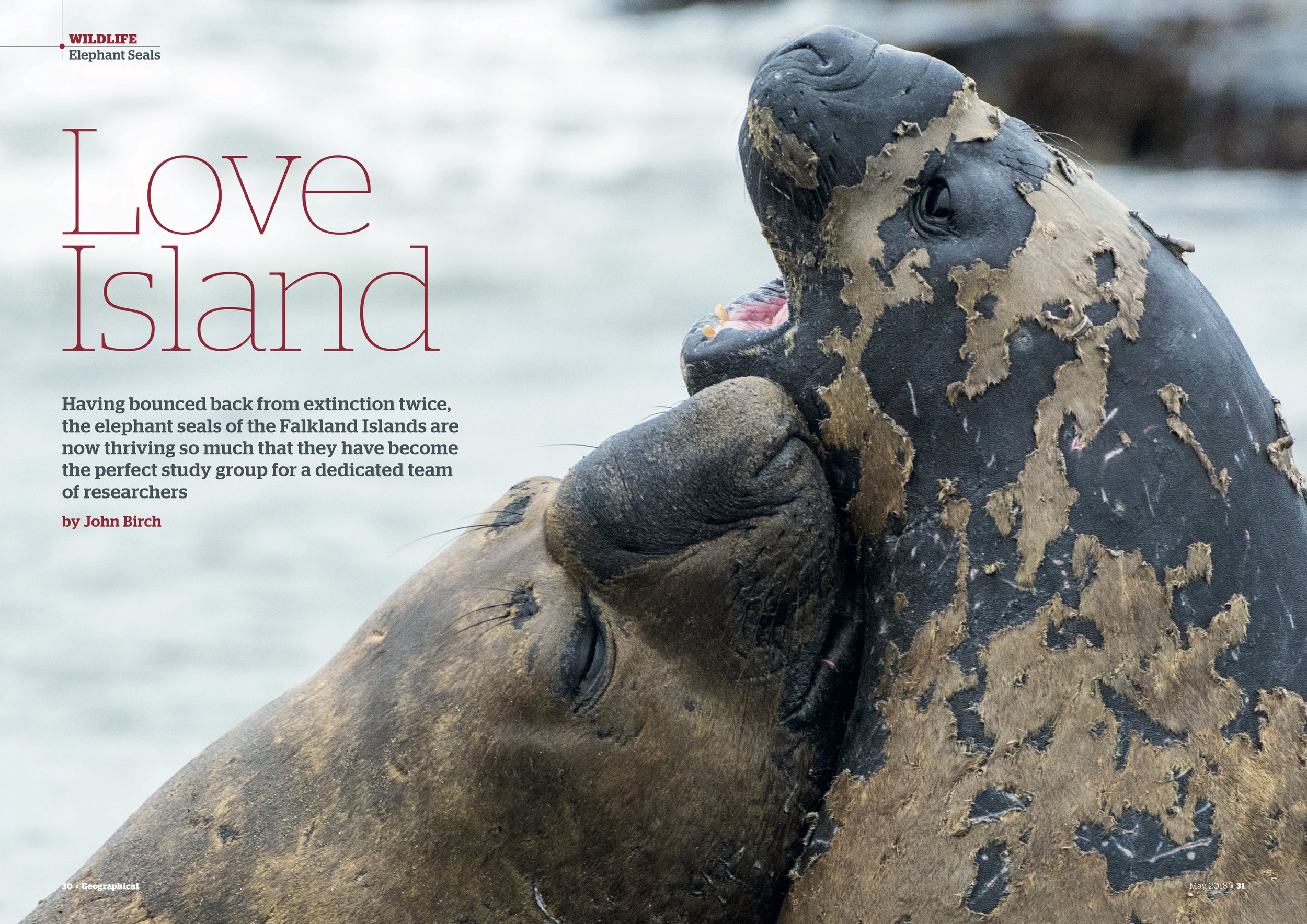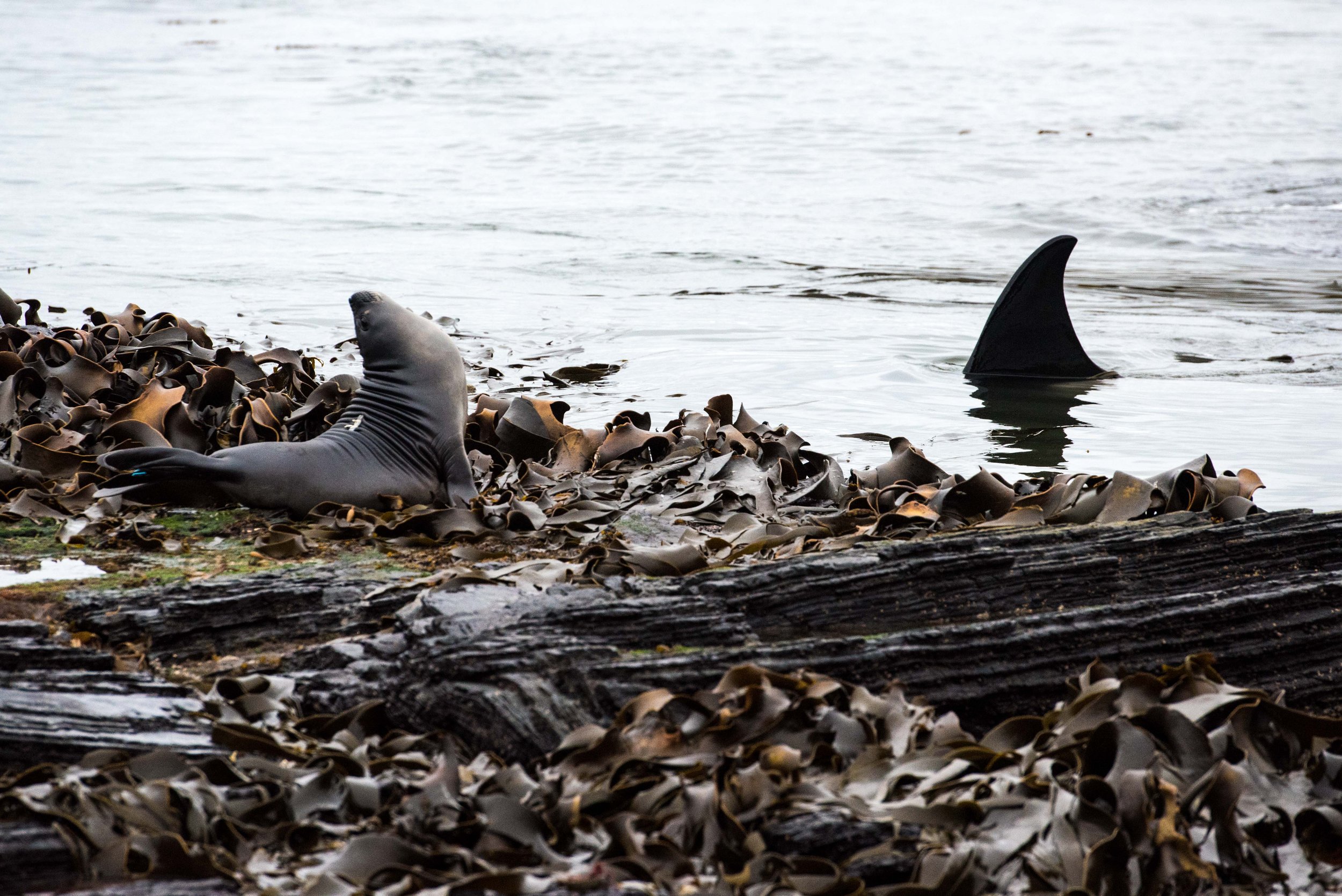Elephant Seals of Sea Lion Island
7 minute read
This article first appeared in Geographical magazine in May 2018
It was 5am on an austral summer’s morning. The large fin of an adult, female killer whale moved slowly but menacingly along the narrow channel alongside the kelp beds. She drew closer to the unsuspecting, weanling elephant seals playing in the shallow water, until reaching a small rock pool at the end when she stopped. There was an invisible barrier beneath the water preventing access to her prey. Nonetheless, the young seals, spotting their nemesis, scurried away, wide-eyed in fear. The orca turned awkwardly, her large body struggling to manoeuvre in the confined space, and retraced her route to the rest of the pod in the open sea.
This exercise was repeated several times. Occasionally an orca calf would follow from a short distance and she was always watched passively by a gathering of southern giant petrels and kelp gulls, bobbing about on the waves about 100 metres out to sea. If she succeeded, then the remains of her breakfast would become theirs.
For their part, some of the elephant seals were alarmed by her presence, others oblivious. An hour passed and the fin once again reached the end of the channel. Then, brief splashes around her tail fin hinted at the wrestling underwater. This time she seemed to be struggling against more than just the confines and the kelp. Moments later she had re-joined the pod and commotion followed. There were flashes of white as an orca slapped its tail fin on the surface and another rolled, exposing its belly. The birds were in the air, climbing and swooping in exultation. A few seconds later, the head of a terrified elephant seal appeared amongst the pod, its eyes wide open in alarm, a gaping tear visible in its left flipper.
Its end, however, was not quick. The orcas toyed with their captive for about twenty minutes before finally killing it, perhaps training their young calf in hunting fieldcraft.
This scene plays itself out on many mornings in November and December on the coast of Sea Lion Island (SLI), one of the southernmost islands in the Falkland Islands archipelago. The elephant seal colony is reaching the end of its breeding cycle and the maximum number of weanlings are learning to swim, fight and hunt in the rock pools next to the beaches on the eastern tip of the island.
To the casual observer, the drama of the kill is inversely proportionate to the complete indifference displayed by the other seals as they laze on the beach or play-fight with one another. It provides clues, however about the motivation and sociology of these unique beings.
Southern elephant seals are the largest of the seal or pinniped family. Their name derives from their huge bulk and the similarity between the male’s extended snout and that of an elephant’s trunk. Adult bulls can grow up to 6m in length and weigh 4000kg; females only normally growing to a quarter of this size. They claim the greatest sexual dimorphism in the animal kingdom.
SLI provides an ideal birthing and breeding location, the low-angled beaches facilitating an easy haul out for these enormous beasts. It also has sufficient infrastructure to provide humans with the best opportunity to gain intimate knowledge of their idiosyncrasies and is home to the longest running research project into mammal biology on the Falkland Islands.
Since 1995, Italian born Fillipo Galimberti and his wife, Simona Sanvito have studied the ecology of the elephant seal population and the distinctive behaviour of breeding individuals. Their Elephant Seal Research Group (ESRG), licensed by the Falkland Islands Government, is an independent organisation of researchers dedicated to this study.
The ESRG previously managed a sister project, researching the northern elephant seals of San Benitos Island, Baja, California. Although this project is no longer active, a PhD student is working on the data collected.
Filippo explains why they chose to study these particular mammals,
“Elephant seals are amazing animals. They deep dive up to 1500 meters, they completely fast for up to three months while on land for breeding and moulting, they are the most sexually dimorphic of all mammals. In a few words, if you like superlatives you will love these animals. We were looking for a species that can be easily marked for individual recognition and observed, and elephant seals are an ideal subject for that.”
They chose SLI for their southern elephant seal research because it has a relatively small, isolated population meaning they can contain their study within numerically manageable bounds. This allows a small research team of between 4-8 people to accurately monitor the behaviour of breeding individuals whilst there are still sufficient numbers to provide meaningful data.
Whilst northern elephant seals have been declared extinct on more than one occasion, their southern relatives have always existed in large numbers. Notwithstanding, by the end of the nineteenth century, commercial seal hunters had killed all the Falkland’s elephant seals. Although they started reappearing within a few years, there have been subsequent local extinction events in 1960 and 1980, for reasons that are not entirely clear. Further, they previously bred in large colonies on other islands in the archipelago but are only now consistently found on SLI.
Between 1989 when the first counts began, elephant seal populations on SLI remained steady but since 2003 have been increasing at a rate of 2-3% each year.
During the breeding season, dedicated researchers are on the beach at first light (about 3.30am in December). Once the breeding hierarchy has been established, the colony is generally calm and the elephant seals are mostly indifferent to their human companions. The researchers remain there throughout the austral summer and spend the entire day living with the seals and carrying out routine duties, such as counts, marking individuals and observing and recording behaviour. They take photographs and video recordings using standard cameras and on occasion, monitoring disposition and numbers with aerial drones. A wide range of laboratory and field techniques are used, including physical tagging and dye-staining to ensure the research they conduct can be disaggregated to the level of the individual seal. To this end, they have marked almost the entire adult breeding population and twenty-two cohorts of pups. Their long day finishes after dark!
In late August, breeding males begin to arrive on the sandy beaches at the eastern-most tip of the island and compete with each other for dominance over the arriving females. They physically challenge one another for sexual supremacyand the resulting fights can occasionally result in serious injury. Once power has been established, the winner or harem holder will have control of breeding rights on their female group for the remainder of the season and whilst a few breeding males are allowed near their harem, the others are kept at the periphery. Filippo explains that one of the most exciting parts of Charles Darwin’s theory of biological evolution was sexual selection and it was the elephant seal’s raw process of sexual selection that provided for ESRG’s original research goals. No animal species displays a higher level of polygyny. Their huge sexual dimorphism is typical evidence of sexual selection.
From early September to November every year, pregnant females haul out onto the beaches in anticipation of giving birth; peak haul out is always 19th or 20th October. The dominant males corral them into harems of over fifty individuals; the smaller males collecting the later arrivals and forming smaller harems at the edges of the colony. On SLI there are approximately twelve harem holders and six hundred breeding females.
Having weaned her pup, she will mate before she returns to sea. Almost all females on SLI have returned to sea by the third week of November, never to see their pup again. Within five weeks, then, the abrupt cycle of confinement; weaning and mating is complete and she has gone.
In her absence, there is no one to defend her youngster from predators or other danger. It is expected to fend for itself. Bulls waste no time looking after or protecting the products of previous years matings in which they are unlikely to have been the sire. Their only concern is to secure more matings for themselves. This indifference to the fate of young weanlings had been most clearly demonstrated during the orca kill.
Molecular biology research methods showed that the few harem holders get the most copulations and sire the most pups. DNA analysis has also provided scientific evidence of the group’s mating patterns and rates of breeding success. ESRG found that a successful male may hold a harem for up to six years. In contrast, most males will fail to achieve a fruitful mating in their lifetime. Harem holders on SLI achieve 94% of the copulations and father 90% of all pups born; siring up to 100 pups in a single season. Polygyny on this scale is the most extreme example in vertebrates.
Simona’s specialist field is animal communication; she describes the incredible noises experienced in an elephant seal colony during the breeding season,
“… pups trying to get the attention of their mothers, females calling their pups to keep them close, and of course males, with their deep voice, challenging one another by means of vocalisations.”
Her analysis of communication has enabled a clearer interpretation of how elephant seals use vocalisation to communicate aggression between agonistic bulls. Her research has shown that during fights for mating rights, the beast with the largest proboscis will usually emit the more threatening sounds and often defuse physical contact altogether as wary challengers back down. Conversely, vocal communication was found to reinforce bonding between females and their pups.
As research objectives reach maturity, new aims are adopted. During the 2009 breeding season, for example, ESRG commenced the deployment of satellite tags on females in order to track their movements at sea. Although tracker deployment has been undertaken on South Georgia, this was the first time it had been used on the Falklands Island’s seals, about whom ESRG already hold such a wide range of background data.
The sample has already highlighted unexpected behaviour, with some females ranging beyond Cape Horn into the Pacific Ocean whilst others remain relatively close to the shores of the Falkland Islands and therefore vulnerable to impact from human activities such as commercial fishing and oil exploration.
There is an acknowledgement that due to its small size and the absence of immigration to the breeding colony, the eco system of SLI is fragile. ESRG understand that a precursor to the preservation of any eco system depends in the first instance on the quality of knowledge about that system. They see their research as the key foundation to conserving this unique population.
The research conducted by ESRG has added hugely to the body of knowledge and learning and continues to do so. Furthermore, they have extended their research into killer whales and skuas on the Falkland Islands. To learn more about their work or to find out how you can provide support, visit their website at www.eleseal.org.









